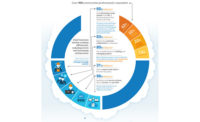As contractors, we clearly understand how the Iron Triangle can affect the success of a project. An increase in the scope of work requires an increase in time and money, or quality will suffer. Most likely we deal with an increase in the scope of work by either increasing manpower, or working overtime. But higher wages and shortages in skilled labor make these options less desirable. So how do you stretch time without spending more money? By increasing productivity. As a manager, I prefer increasing productivity by 10 percent to increasing payroll by the same amount.
For decades, we have looked to technology as the primary source of increasing productivity. We’ve transitioned from 10-key calculators to computers and from walkie-talkies to smart phones. Some contractors have been taking advantage of the improved productivity brought by technology for years. And others are just now looking for ways to begin the transformation.
The use of electronic plans is now widely acceptable in the construction industry. These documents and images are easily loaded into software—therefore dramatically reducing printing and storage costs. The plans reside on a server or a computer hard drive for years without any deterioration in quality, and eliminate the need to store plans and file boxes in your warehouse. Along with the cost saving that comes with switching to electronic plans, there are many other benefits that the contractors enjoy by using automation. All contractors are interested in reducing costs, saving time and eliminating material waste and punch work items. Takeoff, estimating, and project management automation result in these very benefits. Technology eliminates paper plans, paper faxing or mailing, and shows the exact work that should be done—when, where, and how much material is needed.
Reap the Benefits
There are many benefits to technology beyond automatically loading and storing plans. The competition is stiff when bidding for jobs in the construction market, and often what sets one company apart is the accuracy and timeliness of their estimate submittal. As companies are adjusting to working with smaller estimating departments they are looking for automation solutions that will make life easier for the estimators allowing them to increase their bid/win ratio. Changes are inevitable in any construction project’s life cycle, in many instances change orders are issued with minor warnings. We all know you can’t rely on clouded revisions to know what’s changed. With the right automation solution, estimators can easily let the software identify changes and addendums to the plans in a matter of minutes without having to spend countless hours looking over the paper plans.
Technology enables companies to build green. Building green is more than just eliminating paper though. It also means finding ways to reduce material waste, create a better delivery process for materials, and a more accurate oversight of the crew. Construction technology and automation enables project managers to line out the men, knowing how much material will be needed and how long the work should take. Up-to-date stocking reports minimize the chance that excessive materials are ordered and/or delivered to the wrong area or floor.
Field Project Management
I started using various forms of technology and software in the early-’80s, the IBM PC first hit the market. After 20 years, we realized that most of the efficiencies were being gained in the office. But we all know money is made in the field. So over time contractors began looking for software solutions and technologies that will take them to the next level by making the jobsite run efficiently. The introduction of tablet technology in the mid-2000s is transforming field project management. The project manager and foreman are no longer stuck copying and sending papers back and forth regarding the project process or to clarify an aspect of the plans. Plans, change orders, RFIs, etc., are all sent electronically from the tablet in the field to the project manager’s laptop or desktop, wherever he might be. In addition, with automation in the hands of the foreman, at the jobsite location, when an issue arises there are fewer delays and improved steps to resolution.
This gradual shift toward accessing information wherever the contractor is located, whether in the office or the field, or somewhere in between has resulted in an increased use of tablet technology at the jobsite. The use of tablets on the site saves time and improves communications. For example, a foreman or the project manager at the jobsite now has ready access to the latest set of plans, revisions, and change orders. Likewise, cameras in tablets allow a foreman to easily document safety concerns or other issues that can hinder the job from getting completed on time. Such daily logs help contractors stay on budget or monitor and rectify obstacles that can cause lag time in a project.
Avoiding Cost Overruns
A key element to consider in avoiding cost overruns, is knowing who all the players are on the project. This helps with staging and sequencing the work at a greater level of detail. It is at this point that the labor budget strategy is determined. The project is then broken down into floors, rooms, phases, etc. for better job costing. The right size and mix of the crew is determined. Site and stocking considerations are reviewed.
The next extensive analysis before start of construction is around developing a construction ready budget. The best budgets are collaborative, credible and measurable. This collaboration/teamwork starts between the estimator and the project manager, and is then carried on between the project manager and the site foreman. The budget deliverables include: a color-coded quantity takeoff, detailed color-coded labor costs, a solution to keep track of the budget, reports for additional material, scope and change order updates. The takeoff and pricing is done with the foreman. Because of this collaboration, when the foreman receives the color-coded plans and corresponding stocking list and labor budget it is then easier to track and manage the job.
Contractors are using tablets in the field to digitally sign contracts, enter payroll hours, fill out progress reports, capture and organize photos of the project, and line-out the crew while identifying the daily scope of work. Software solutions allow the foreman/project manager to assign tasks to one or many crew members at the start of each day using the estimated production rate. Thanks to automation, guessing the amount of scope the crew should accomplish on any given day is no longer necessary. Using automation wisely, the project manager can avoid overruns by looking at actual labor worked and materials installed.
Cost overruns are a major headache, because they affect the bottom line and often go undetected till the end of the job. Effective project management software can alleviate this headache by monitoring the labor production output and instantly spotting any production lags. Successful project management packages illustrate when the project is over, under, or right at budget.
Six Components of Job Cost Management
A common complaint among foreman and project managers is that they do not have the information to effectively monitor and manage their labor costs. In most cases, the data is available. Job cost management requires six components: estimated quantities, estimated hours, method to measure installed quantities and corresponding hours, percentage complete to calculate earned value, actual payroll data, and a report to calculate job-to-date (JTD) and projected costs. When this information is readily available, the foreman and the project manager must review this data. When done in a timely manner, such as each week, they know if the project is making money and what the projected profit margin is at the end of the job. Additionally, they have the ability to look at the number and dive in if it looks wrong. It is possible to turn around a “losing” job if it is done early in construction (approximately 25 percent complete). The longer a problem goes unnoticed the less time there is to react and the lower the likelihood that it can be positively affected.
No software program can guarantee a company will win every contract, but a quality program helps contractors stretch time, manage day-to-day functions, increase productivity and raise profit margins. In the end, it comes down to getting the right information in the right hands, at the right time.







